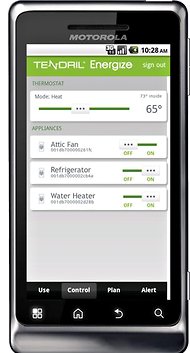
The White House hopes that someday soon everyone will be able to monitor and control their home energy usage, and lower their monthly utility bills, with a few swipes on a smartphone app. At least that’s the vision of the Green Button initiative, a recent White House effort to bring together the nation’s utilities, energy consumers and private industry to develop Internet and mobile phone-style technologies and business models aimed at reducing energy consumption.
 TendrilApps like Tendril Energize work with Green Button data to allow homeowners to manage their energy usage remotely.
TendrilApps like Tendril Energize work with Green Button data to allow homeowners to manage their energy usage remotely.
At an event on Wednesday in Silicon Valley, California’s three major utilities – Pacific Gas and Electric, San Diego Gas Electric and Southern California Edison – became the first in the nation to announce they now support Green Button. Together the utilities serve about 10 million households.
The companies have worked together to make this data available to homeowners since Aneesh Chopra, President Obama’s chief technology officer, issued the challenge last fall. Mr. Chopra, who delivered the keynote address at Wednesday’s event, predicted that other major utilities around the country would follow California’s lead.
Through its Green Button program, the government hopes to coax all utility companies across the country to collect and produce energy usage data for homeowners in a standard format they can download at any time from a utility’s Web site.
Making this data available to the public would in principle lead private-sector companies to develop technologies like energy management systems and smartphone applications that can interpret and use the information. Homeowners in turn would seek out the applications that enable them to gain greater control over their home energy usage and save money, the thinking goes.
Mr. Chopra described the government’s involvement in this effort as a “cheerleader and impatient convener,” but emphasized that the endeavor would depend on private industry. Many of those players were represented at the event. Energy technology companies like Opower and Tendril described Green Button-compatible products they are building.
Tendril’s chief executive, Adrian Tuck, said his company had created a set of software development tools that had already attracted 150 app developers. His company also plans to set up an online marketplace, similar to Apple’s iPhone App Store or Google’s Android Market, where homeowners could download energy-related applications.
Simple Energy demonstrated its online game program that turns energy management into a competition. The company recently began trials of the game, along with Tendril’s energy monitoring device, with 200 residential energy customers in Texas and the San Diego area. Among San Diego Gas Electric customers who took part in a three-month energy savings contest last fall, the average monthly savings was 20 percent. The winner, called the Biggest Saver, reduced her energy usage by about 45 percent, according to the company, and won a laptop computer.
Providing the data in standard formats according to industry-accepted guidelines will be fundamental to expanding this market, Mr. Chopra said. A standard format allows software developers to create one version of their product that will work for all utility customers across the country. In this case, Green Button has adopted a standard developed by the North American Energy Standards Board, an industry-led group.
Building a smart electric grid, needed to support programs like Green Button, will also rely on consumer uptake of technologies like smart meters and appliances that offer up timely and detailed information on home energy use. Widespread adoption of these technologies is still some time off. According to recent studies by Pike Research, a clean tech research firm, only 22 percent of homes in the United States have smart meters. And privacy concerns have prompted some homeowners to block installation of these meters.
Still, Mr. Chopra is confident that Green Button will gain momentum with consumers and drive forward the other players in this market. At Wednesday’s event, he cited the success of Blue Button, a similar government program that allows military personnel to obtain their medical records maintained by Department of Veterans Affairs. Since Blue Button was offered in October 2010, more than 500,000 veterans have downloaded their records, and a growing portfolio of health care-related companies are building products to use this data, he said.
Article source: http://feeds.nytimes.com/click.phdo?i=aa609407039919ec4fc1b985281a2abd
Speak Your Mind
You must be logged in to post a comment.